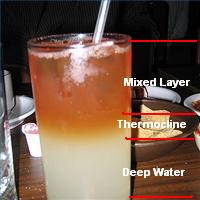|
The water temperature at the Erie Pennsylvania water treatment plant tends to fluctuate by several degrees every spring. This is caused by a fluctuation in the level of the thermocline. A thermocline is a transition layer between deep and surface water (or mixed layer). The definitions of these layers are based on temperature. The mixed layer is near the surface where the temperature is roughly that of surface water. In the thermocline, the temperature decreases rapidly from the mixed layer temperature to the much colder deep water temperature. The mixed layer and the deep water layer are relatively uniform in temperature, while the thermocline represents the transition zone between the two. |
|
| The mixed layer warms the fastest due to the high sun angle and warm air interacting with the water. During periods of light to calm winds, the water remains warm near the surface. Once the wind increases over the lake causing wave action, the warmer mixed layer at the surface starts to mingle with the deep water which results in a fluctuation of the depth of the thermocline. As this depth fluctuates, a stationary thermometer in the water can record these rapid changes. | |
 |
A good example is a popular beverage where ice cold lemonade (deep water layer) is poured into a glass with warm ice tea (mixed layer) poured slowly on top of the lemonade. The result is a separation of the fluid because of the difference in temperature. As you can see, the warm ice tea remains at the top of the glass while the ice cold lemonade remains at the bottom. The thermocline is the layer where the two fluids intermingle. Once you stir the glass (simulates wind creating wave action) with a straw, the two fluids will mix and cause the thermocline to disappear or fluctuate in depth. |